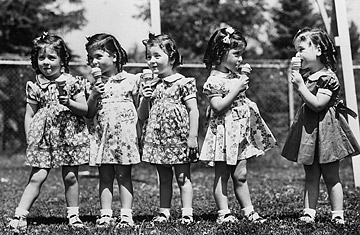
On their 4th birthday, the fast-growing Dionne quintuplets received ice cream cones as a special treat. From left: Emilie, Annette, Marie, Cecile and Yvonne
Cecile Dionne learned to say "doctor" before she did "mother." As one of the Dionne girls — the first set of quintuplets to survive infancy, born 75 years ago on May 28 — Cecile spent her first nine years under medical care in "Quintland," a hospital that essentially doubled as a government-run theme park. Born in Ontario to a pair of devout Catholics (who had, and would produce, several additional children), the Dionne quintuplets were an immediate media sensation, a Depression-era precursor to today's Octomoms and Jon and Kates. Two months premature, weighing about 2 lb. each, Cecile, Annette, Yvonne, Marie and Emilie were quickly made wards of the state by authorities, who feared that their father would exploit them for his own financial benefit. Then, in a supreme irony, the quints were set up in a hospital directly across the street from their parents' farmhouse, where tourists and passersby lined up for hours to gawk. The local service station, which began to rake in the dough as people flocked to "Quintland," had five gas pumps, each named for one of the girls. The town and government both benefited greatly; at one point, the Dionne Quintuplets were considered a more popular tourist attraction than Niagara Falls.
At one spot along the queue outside the hospital lay a pile of rocks dubbed "fertility stones." The thought was that their proximity to such a miracle of reproductive biology — five girls! — might help mothers who were finding it difficult to conceive. Modern society has no need for good-luck charms, however. All one needs is nine months, several thousand dollars and a good ob-gyn.
Thanks to in vitro fertilization (IVF), the skyrocketing use of fertility drugs and the increasing number of women who delay childbearing until their 30s or 40s, the incidences of multiple births have increased in the past two decades. In 1980, IVF — in which hormones are used to induce the production of eggs, which are externally fertilized and then implanted back into the uterus — became available in the U.S. Since then, the percentage of twins and triplets as a proportion of total births has increased several-fold. It's almost as if no one is impressed by them anymore. Two kids? Blah. Three kids? A teeny bit warmer. But quadruplets, quintuplets, sextuplets, septuplets, octuplets? Now we're talking. Multiple births have become easier, yet the dangers are very real for both mothers and children alike. (See the top 10 medical breakthroughs of 2008.)
Multiples, as opposed to singletons, are more likely to be born premature (the more fetuses, the earlier labor occurs). The risk of miscarriage is higher. Cesarean sections are utilized more frequently. Gestational diabetes, hypertension and preeclampsia can all occur. Multiple births can also create potential long-term health implications for the children, like cerebral palsy. In the short term, in many multiple-birth situations, newborns are at greater risk of birth complications and death, though notably, all eight of the kids born to "Octomom" Nadya Suleman earlier this year survived.
Now clearly, the chances of naturally conceiving eight children at once are well-nigh impossible. And the facts of Suleman's conception — she had six embryos implanted in her womb, two of which split into twins — are troubling. Medical guidelines limit the practice to one or two implanted embryos at most. A fertility expert quoted in the Los Angeles Times noted that octuplets are "unbelievably rare. When people use fertility drugs, 80% even then are single births. The vast majority of the others are twins." By that token, Suleman, who is entertaining offers of a reality show and has reportedly fired her troupe of free nurses because she thought they were spying on her, was just extremely lucky (or unlucky, if you consider the crippling cost of raising eight children).
Aside from an appealing sense of rarity, multiple births carry a nostalgic whiff of the idea of a big, sprawling family at a time when the American nuclear family is largely shrinking. Shows like TLC's Duggar's Big Family Album, on which an Arkansas couple flaunts their 17 (!) children, or the same network's Jon & Kate Plus 8 (more like Jon & Kate Plus 8 Plus The People They're Reportedly Having Affairs With) sell the idea of multiples as special. In the case of Jon and Kate Gosselin, who gave birth to a set of twins and a set of sextuplets, they were doubly blessed. Even before the TV show, their Pennsylvania community kicked in with financial, material and moral support. Such warmth and attention can drive people to extremes, though. In August 2006, a Missouri couple admitted to conning their neighbors out of some cash by faking the birth of sextuplets. Everyone thought it was a miracle.
